Blog
Why Your Toes Might Hurt and What to Do About It
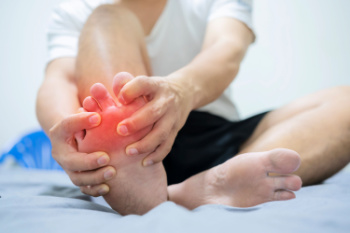
Toe pain can make everyday activities uncomfortable, whether you are walking, running, or simply wearing shoes. Common causes include bunions, hammertoes, ingrown toenails, and arthritis. Repetitive stress from wearing tight shoes, high-impact activities, or foot deformities can also lead to inflammation and pain in the toes. If your toes are sore, swollen, or stiff, rest may provide temporary relief. Wearing shoes with a roomy toe box and good arch support can ease pressure on the joints. Stretching and strengthening exercises can improve flexibility and reduce discomfort. Persistent toe pain may signal a more serious problem, such as a stress fracture or nerve issue. If the pain does not improve or worsens, it is suggested that you see a podiatrist, who can diagnose the cause and recommend the right treatment.
Toe pain can disrupt your daily activities. If you have any concerns, contact Jack A. Sasiene, DPM of Texas. Our doctor can provide the care you need to keep you pain-free and on your feet.
What Causes Toe Pain?
Most severe toe pain is caused due to a sports injury, trauma from dropping something heavy on the toe, or bumping into something rigid. Other problems can develop over time for various reasons.
Toe pain can be caused by one or more ailments. The most common include:
- Trauma
- Sports injury
- Wearing shoes that are too tight
- Arthritis
- Gout
- Corns and calluses
- Hammertoe
- Bunions
- Blisters
- Ingrown toenails
- Sprains
- Fractures (broken bones)
- Dislocations
When to See a Podiatrist
- Severe pain
- Persistent pain that lasts more than a week
- Signs of infection
- Continued swelling
- Pain that prevents walking
Diagnosis
In many cases the cause of toe pain is obvious, but in others, a podiatrist may want to use more advanced methods to determine the problem. These can range from simple visual inspections and sensation tests to X-rays and MRI scans. Prior medical history, family medical history, and any recent physical traumatic events will all be taken into consideration for a proper diagnosis.
Treatment
Treatments for toe pain and injuries vary and may include shoe inserts, padding, taping, medicines, injections, and in some cases, surgery. If you believe that you have broken a toe, please see a podiatrist as soon as possible.
If you have any questions please feel free to contact our offices located in Texas City and Lake Jackson, TX . We offer the newest diagnostic tools and technology to treat your foot and ankle needs.
Heel Pain Can Be Treated!
Protecting Your Feet if You Have Diabetes
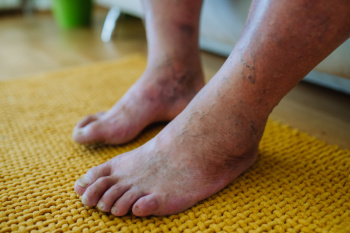
If you have diabetes, taking care of your feet is essential. High blood sugar can damage nerves, causing numbness and reducing blood flow, making it harder for even small cuts or blisters to heal. This increases the risk of serious complications, including infections and ulcers, which can lead to limb loss, if not properly managed. Daily foot care is one of the best ways to prevent problems. Inspect your feet each day for cuts, redness, swelling, or signs of infection. Keep your feet clean, moisturized, and always wear shoes to protect against injury. Regular trimming of toenails, properly fitting footwear, and managing your blood sugar are also key to keeping your feet healthy. Even without symptoms, people with diabetes benefit from regular foot exams. If you are part of this population, it is suggested that you schedule an appointment with a podiatrist for a comprehensive foot evaluation and personalized care plan to help prevent complications.
Diabetic foot care is important in preventing foot ailments such as ulcers. If you are suffering from diabetes or have any other concerns about your feet, contact Jack A. Sasiene, DPM from Texas. Our doctor can provide the care you need to keep you pain-free and on your feet.
Diabetic Foot Care
Diabetes affects millions of people every year. The condition can damage blood vessels in many parts of the body, especially the feet. Because of this, taking care of your feet is essential if you have diabetes, and having a podiatrist help monitor your foot health is highly recommended.
The Importance of Caring for Your Feet
- Routinely inspect your feet for bruises or sores.
- Wear socks that fit your feet comfortably.
- Wear comfortable shoes that provide adequate support.
Patients with diabetes should have their doctor monitor their blood levels, as blood sugar levels play such a huge role in diabetic care. Monitoring these levels on a regular basis is highly advised.
It is always best to inform your healthcare professional of any concerns you may have regarding your feet, especially for diabetic patients. Early treatment and routine foot examinations are keys to maintaining proper health, especially because severe complications can arise if proper treatment is not applied.
If you have any questions please feel free to contact our offices located in Texas City and Lake Jackson, TX . We offer the newest diagnostic and treatment technologies for all your foot and ankle needs.
How to Manage an Ingrown Toenail
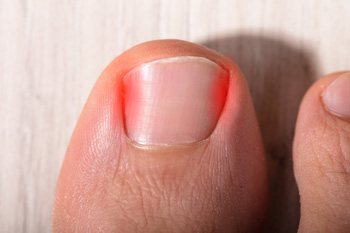
Ingrown toenails occur when the edges of the nail grow into the surrounding skin, causing pain, redness, and swelling. The area may become tender, and in some cases, it can become infected, leading to pus or an increased risk of complications. The primary causes of ingrown toenails include improper nail trimming, wearing tight shoes, or having naturally curved nails. This condition often results in sharp, throbbing pain, especially when pressure is applied, such as while walking or wearing shoes. A podiatrist can help by gently lifting the ingrown nail or, in more severe cases, removing part of the nail. This type of doctor may also recommend methods to prevent recurrence, such as proper nail care and footwear adjustments. If you are experiencing painful ingrown toenails, it is suggested that you schedule an appointment with a podiatrist.
Ingrown toenails may initially present themselves as a minor discomfort, but they may progress into an infection in the skin without proper treatment. For more information about ingrown toenails, contact Jack A. Sasiene, DPM of Texas. Our doctor can provide the care you need to keep you pain-free and on your feet.
Ingrown Toenails
Ingrown toenails are caused when the corner or side of a toenail grows into the soft flesh surrounding it. They often result in redness, swelling, pain, and in some cases, infection. This condition typically affects the big toe and may recur if it is not treated properly.
Causes
- Improper toenail trimming
- Genetics
- Improper shoe fitting
- Injury from pedicures or nail picking
- Abnormal gait
- Poor hygiene
You are more likely to develop an ingrown toenail if you are obese, have diabetes, arthritis, or have any fungal infection in your nails. Additionally, people who have foot or toe deformities are at a higher risk of developing an ingrown toenail.
Symptoms
Some symptoms of ingrown toenails are redness, swelling, and pain. In rare cases, there may be a yellowish drainage coming from the nail.
Treatment
Ignoring an ingrown toenail can have serious complications. Infections of the nail border can progress to a deeper soft-tissue infection, which can then turn into a bone infection. You should always speak with your podiatrist if you suspect you have an ingrown toenail, especially if you have diabetes or poor circulation.
If you have any questions, please feel free to contact our offices located in Texas City and Lake Jackson, TX . We offer the newest diagnostic and treatment technologies for all your foot care needs.
How Gait Disorders in Seniors Impact Their Feet

Gait disorders in the elderly significantly affect the feet, leading to discomfort, instability, and a higher risk of falls. These conditions often result from musculoskeletal issues, neurological disorders, or chronic diseases, such as arthritis and diabetes. Weakness in the foot muscles, joint stiffness, and loss of sensation contribute to unsteady movement, increasing the likelihood of injuries. Pain and deformities like bunions or hammertoes further disrupt balance, making walking difficult. Reduced mobility leads to a loss of freedom and independence, affecting mental well-being and overall quality of life. Fear of falling may cause seniors to limit their activities, resulting in muscle weakness and further instability. If you are elderly or caring for an elderly individual and notice a change in the feet or walking patterns, it is suggested that you consult a podiatrist who can offer corrective treatment and proper foot health guidance.
Proper foot care is something many older adults forget to consider. If you have any concerns about your feet and ankles, contact Jack A. Sasiene, DPM from Texas. Our doctor can provide the care you need to keep you pain-free and on your feet.
The Elderly and Their Feet
As we age we start to notice many changes in our body, but the elder population may not notice them right away. Medical conditions may prevent the elderly to take notice of their foot health right away. Poor vision is a lead contributor to not taking action for the elderly.
Common Conditions
- Neuropathy – can reduce feeling in the feet and can hide many life-threatening medical conditions.
- Reduced flexibility – prevents the ability of proper toenail trimming, and foot cleaning. If left untreated, it may lead to further medical issues.
- Foot sores – amongst the older population can be serious before they are discovered. Some of the problematic conditions they may face are:
- Gouging toenails affecting nearby toe
- Shoes that don’t fit properly
- Pressure sores
- Loss of circulation in legs & feet
- Edema & swelling of feet and ankles
Susceptible Infections
Diabetes and poor circulation can cause general loss of sensitivity over the years, turning a simple cut into a serious issue.
If you have any questions please feel free to contact our offices located in Texas City and Lake Jackson, TX . We offer the newest diagnostic and treatment technologies for all your foot and ankle needs.
Understanding Venous Ulcers and Their Impact on Lower Limbs

Venous ulcers are slow-healing wounds caused by poor circulation in the veins, typically in the lower legs and ankles. They develop when blood pools due to faulty valves, leading to increased pressure and skin breakdown. These ulcers often appear as shallow, irregular sores with discoloration, swelling, and discomfort. Individuals at higher risk include those with varicose veins, deep vein thrombosis, DVT, obesity, or a history of leg injuries. People who stand or sit for prolonged periods may also develop these chronic wounds. Venous ulcers directly affect the feet and ankles by causing swelling, skin changes, and persistent wounds prone to infection. Without proper care, complications may arise. Compression therapy, wound management, and lifestyle changes help improve healing. If you have venous ulcers, it is strongly suggested that you include a podiatrist on your healthcare team for effective treatment and prevention.
Wound care is an important part in dealing with diabetes. If you have diabetes and a foot wound or would like more information about wound care for diabetics, consult with Jack A. Sasiene, DPM from Texas. Our doctor will assess your condition and provide you with quality foot and ankle treatment.
What Is Wound Care?
Wound care is the practice of taking proper care of a wound. This can range from the smallest to the largest of wounds. While everyone can benefit from proper wound care, it is much more important for diabetics. Diabetics often suffer from poor blood circulation which causes wounds to heal much slower than they would in a non-diabetic.
What Is the Importance of Wound Care?
While it may not seem apparent with small ulcers on the foot, for diabetics, any size ulcer can become infected. Diabetics often also suffer from neuropathy, or nerve loss. This means they might not even feel when they have an ulcer on their foot. If the wound becomes severely infected, amputation may be necessary. Therefore, it is of the upmost importance to properly care for any and all foot wounds.
How to Care for Wounds
The best way to care for foot wounds is to prevent them. For diabetics, this means daily inspections of the feet for any signs of abnormalities or ulcers. It is also recommended to see a podiatrist several times a year for a foot inspection. If you do have an ulcer, run the wound under water to clear dirt from the wound; then apply antibiotic ointment to the wound and cover with a bandage. Bandages should be changed daily and keeping pressure off the wound is smart. It is advised to see a podiatrist, who can keep an eye on it.
If you have any questions, please feel free to contact our offices located in Texas City and Lake Jackson, TX . We offer the newest diagnostic and treatment technologies for all your foot care needs.
Common Reasons for Burning Foot Pain
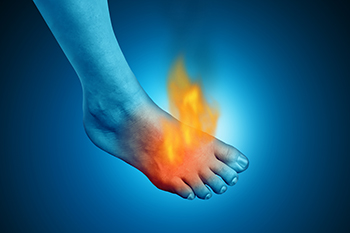
Burning feet can result from various conditions that affect the nerves, blood flow, or soft tissues of the foot and ankle. Peripheral neuropathy is a common cause of burning feet. It is often linked to diabetes or nerve compression, and can lead to sensations of burning, tingling, or numbness. Morton’s neuroma, a thickening of tissue around a nerve in the ball of the foot, can also cause a burning sensation, particularly when walking. Tarsal tunnel syndrome, which involves compression of the tibial nerve near the ankle, may result in burning pain along the inner foot and toes. Other possible causes of burning foot pain include peripheral vascular disease, which restricts blood flow and may lead to burning pain during movement, and metatarsalgia, where excessive pressure on the forefoot leads to irritation and discomfort. Some inherited nerve disorders, such as Charcot-Marie-Tooth disease, can also contribute to persistent burning sensations in the feet. A podiatrist can diagnose the cause of burning feet and offer treatment options, including orthotics, medication, or surgery, if needed. If you frequently experience the sensation of burning feet, it is suggested that you schedule an appointment with a podiatrist for an exam, diagnosis and appropriate treatment.
Foot Pain
Foot pain can be extremely painful and debilitating. If you have a foot pain, consult with Jack A. Sasiene, DPM from Texas. Our doctor will assess your condition and provide you with quality foot and ankle treatment.
Causes
Foot pain is a very broad condition that could be caused by one or more ailments. The most common include:
- Bunions
- Hammertoes
- Plantar Fasciitis
- Bone Spurs
- Corns
- Tarsal Tunnel Syndrome
- Ingrown Toenails
- Arthritis (such as Gout, Rheumatoid, and Osteoarthritis)
- Flat Feet
- Injury (from stress fractures, broken toe, foot, ankle, Achilles tendon ruptures, and sprains)
- And more
Diagnosis
To figure out the cause of foot pain, podiatrists utilize several different methods. This can range from simple visual inspections and sensation tests to X-rays and MRI scans. Prior medical history, family medical history, and any recent physical traumatic events will all be taken into consideration for a proper diagnosis.
Treatment
Treatment depends upon the cause of the foot pain. Whether it is resting, staying off the foot, or having surgery; podiatrists have a number of treatment options available for foot pain.
If you have any questions, please feel free to contact our offices located in Texas City and Lake Jackson, TX . We offer the newest diagnostic and treatment technologies for all your foot care needs.
Reminder: When Was the Last Time...?
Symptoms and Causes of Bunions
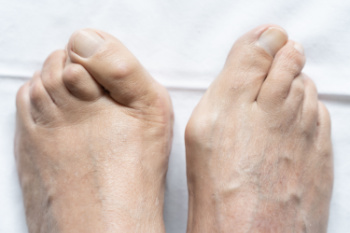
Bunions are bony bumps that form at the base of the big toe, while the tip of the toe angles inward toward the other toes. This misalignment can lead to pain, swelling, and difficulty moving the toe. Symptoms often include redness, tenderness, and a visible bump at the joint. Risk factors for bunions include wearing tight, ill-fitting shoes, particularly high heels, which put pressure on the toes. Genetics can also play a role, as bunions often run in families. Other factors, such as arthritis or foot deformities, can increase the likelihood of developing bunions. To prevent bunions, it is important to wear shoes that fit properly, provide enough toe room, and offer proper arch support. Regularly stretching and strengthening the feet can also help reduce the risk of bunions and alleviate discomfort if they develop. If you have the beginning signs of a bunion, it is suggested that you consult a podiatrist who can offer you effective relief, and additional prevention strategies.
If you are suffering from bunion pain, contact Jack A. Sasiene, DPM of Texas. Our doctor can provide the care you need to keep you pain-free and on your feet.
What Is a Bunion?
Bunions are painful bony bumps that usually develop on the inside of the foot at the joint of the big toe. As the deformity increases over time, it may become painful to walk and wear shoes. Women are more likely to exacerbate existing bunions since they often wear tight, narrow shoes that shift their toes together. Bunion pain can be relieved by wearing wider shoes with enough room for the toes.
Causes
- Genetics – some people inherit feet that are more prone to bunion development
- Inflammatory Conditions - rheumatoid arthritis and polio may cause bunion development
Symptoms
- Redness and inflammation
- Pain and tenderness
- Callus or corns on the bump
- Restricted motion in the big toe
In order to diagnose your bunion, your podiatrist may ask about your medical history, symptoms, and general health. Your doctor might also order an x-ray to take a closer look at your feet. Nonsurgical treatment options include orthotics, padding, icing, changes in footwear, and medication. If nonsurgical treatments don’t alleviate your bunion pain, surgery may be necessary.
If you have any questions, please feel free to contact our offices located in Texas City and Lake Jackson, TX . We offer the newest diagnostic and treatment technologies for all your foot care needs.
Plantar Heel Pain in Middle Age and Beyond
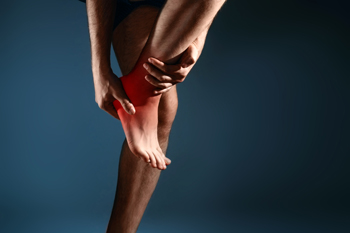
Plantar heel pain becomes increasingly common in middle age and older adults due to years of wear and tear on the feet. The plantar fascia, a thick band of tissue supporting the arch, loses elasticity over time, making it more prone to microtears and inflammation. Conditions like plantar fasciitis and heel spurs often develop, leading to sharp, stabbing pain, especially during the first steps in the morning. Age-related changes such as reduced fat padding in the heel, decreased flexibility, and weakened foot muscles contribute to the problem. Standing for long periods of time during the day, excessive walking, or wearing unsupportive shoes can worsen symptoms. Maintaining foot health through wearing proper footwear, stretching, and orthotic support can help alleviate discomfort. If you have heel pain that persists or interferes with daily movement, it is suggested that you seek professional evaluation and treatment from a podiatrist.
Many people suffer from bouts of heel pain. For more information, contact Jack A. Sasiene, DPM of Texas. Our doctor can provide the care you need to keep you pain-free and on your feet.
Causes of Heel Pain
Heel pain is often associated with plantar fasciitis. The plantar fascia is a band of tissues that extends along the bottom of the foot. A rip or tear in this ligament can cause inflammation of the tissue.
Achilles tendonitis is another cause of heel pain. Inflammation of the Achilles tendon will cause pain from fractures and muscle tearing. Lack of flexibility is also another symptom.
Heel spurs are another cause of pain. When the tissues of the plantar fascia undergo a great deal of stress, it can lead to ligament separation from the heel bone, causing heel spurs.
Why Might Heel Pain Occur?
- Wearing ill-fitting shoes
- Wearing non-supportive shoes
- Weight change
- Excessive running
Treatments
Heel pain should be treated as soon as possible for immediate results. Keeping your feet in a stress-free environment will help. If you suffer from Achilles tendonitis or plantar fasciitis, applying ice will reduce the swelling. Stretching before an exercise like running will help the muscles. Using all these tips will help make heel pain a condition of the past.
If you have any questions please contact our offices located in Texas City and Lake Jackson, TX . We offer the newest diagnostic and treatment technologies for all your foot and ankle needs.
More...
Choosing the Right Running Shoes for Different Terrains

Selecting the right running shoes for your intended terrain is essential for comfort, performance, and injury prevention. For road running, choose lightweight shoes with adequate cushioning to absorb impact on hard, flat surfaces. Look for breathable materials and a snug fit to prevent blisters during longer runs. Trail running requires sturdier shoes with rugged soles for better grip on uneven, rocky, or muddy terrain. Waterproof or water-resistant materials can keep your feet dry in wet conditions. For treadmill running, focus on shoes with shock absorption and flexibility to handle the repetitive motion. Always consider your foot type, such as flat feet or high arches, when choosing shoes to ensure proper support and alignment. Worn or inappropriate shoes can lead to discomfort or injury. For expert guidance on choosing the right running shoes for yourself, it is suggested that you see a podiatrist to ensure your footwear matches your running needs.
You should always make sure your running shoes fit properly in order to avoid injury. For more information, contact Jack A. Sasiene, DPM from Texas. Our doctor can provide the care you need to keep you pain-free and on your feet.
Choosing the Right Running Shoe for Your Foot Type
Improper shoe sizing can cause a myriad of problems for your feet. Shoes that don’t fit you properly can lead to muscular imbalances in your body, which can result in foot, knee, and hip injuries.
Tips for Finding the Right Running Shoe
- Make sure you have a thumb’s width of wiggle room between the end of your longest toe and the front of the shoe.
- There should be little to no slipping at the heel
- Don’t assume your size in one shoe brand will be your size in another
- Do not lace up your shoes too tightly
- Walk around in the store with your new shoes before you buy them
If you have any questions please feel free to contact our our offices located in Texas City and Lake Jackson, TX . We offer the newest diagnostic and treatment technologies for all your foot and ankle needs.
Sesamoiditis Facts
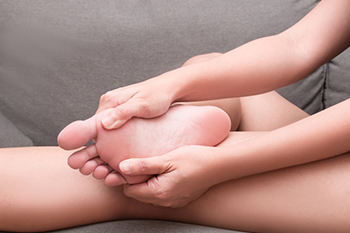
Sesamoiditis is named after the sesamoid bones, which are small, pea-shaped bones embedded in tendons beneath the big toe joint. These bones act like pulleys, aiding movement and bearing weight. Sesamoiditis occurs when these bones or surrounding tendons become inflamed, often due to repetitive stress or overuse. It is common among athletes, dancers, and individuals who engage in activities requiring frequent toe pressure, such as running or jumping. People with high arches or those who wear high heels are also at a higher risk. Symptoms include pain beneath the big toe, swelling, and difficulty bearing weight. Left untreated, it may lead to chronic discomfort or restricted mobility. If you have this type of foot pain, it is suggested that you schedule an appointment with a podiatrist who can provide an accurate diagnosis and offer treatments like orthotics, activity modification, or in severe cases, surgery. Early care helps alleviate pain and prevent further damage.
Sesamoiditis is an unpleasant foot condition characterized by pain in the balls of the feet. If you think you’re struggling with sesamoiditis, contact Jack A. Sasiene, DPM of Texas. Our doctor will treat your condition thoroughly and effectively.
Sesamoiditis
Sesamoiditis is a condition of the foot that affects the ball of the foot. It is more common in younger people than it is in older people. It can also occur with people who have begun a new exercise program, since their bodies are adjusting to the new physical regimen. Pain may also be caused by the inflammation of tendons surrounding the bones. It is important to seek treatment in its early stages because if you ignore the pain, this condition can lead to more serious problems such as severe irritation and bone fractures.
Causes of Sesamoiditis
- Sudden increase in activity
- Increase in physically strenuous movement without a proper warm up or build up
- Foot structure: those who have smaller, bonier feet or those with a high arch may be more susceptible
Treatment for sesamoiditis is non-invasive and simple. Doctors may recommend a strict rest period where the patient forgoes most physical activity. This will help give the patient time to heal their feet through limited activity. For serious cases, it is best to speak with your doctor to determine a treatment option that will help your specific needs.
If you have any questions please feel free to contact our offices located in Texas City and Lake Jackson, TX . We offer the newest diagnostic and treatment technologies for all your foot and ankle needs.
Do You Suffer From Painful Feet?
Surgery for an Ingrown Toenail

An ingrown toenail occurs when the edge of a toenail grows into the surrounding skin causing pain, redness, swelling, and sometimes infection. This condition is most common on the big toe and can occur from improper nail trimming, wearing tight shoes, or injury to the toe. When conservative treatments such as soaking, proper nail care, and antibiotics for infection do not provide relief, ingrown toenail surgery may be necessary. A podiatrist numbs the toe with a local anesthetic during the procedure to ensure comfort. This is followed by carefully removing the portion of the nail that is growing into the skin. In more severe cases, part of the nail bed may also be removed to prevent the nail from growing back into the skin. The area is cleaned and a dressing is applied. With proper care and hygiene, recovery typically takes a few weeks to ensure a successful healing process. If you have an ingrown toenail, it is suggested that you contact a podiatrist who can provide the best treatment solutions which may include surgery.
Ingrown toenails can become painful if they are not treated properly. For more information about ingrown toenails, contact Jack A. Sasiene, DPM of Texas. Our doctor can provide the care you need to keep you pain-free and on your feet.
Ingrown Toenails
Ingrown toenails occur when a toenail grows sideways into the bed of the nail, causing pain, swelling, and possibly infection.
Causes
- Bacterial infections
- Improper nail cutting such as cutting it too short or not straight across
- Trauma to the toe, such as stubbing, which causes the nail to grow back irregularly
- Ill-fitting shoes that bunch the toes too close together
- Genetic predisposition
Prevention
Because ingrown toenails are not something found outside of shoe-wearing cultures, going barefoot as often as possible will decrease the likeliness of developing ingrown toenails. Wearing proper fitting shoes and using proper cutting techniques will also help decrease your risk of developing ingrown toenails.
Treatment
Ingrown toenails are a very treatable foot condition. In minor cases, soaking the affected area in salt or antibacterial soaps will not only help with the ingrown nail itself, but also help prevent any infections from occurring. In more severe cases, surgery is an option. In either case, speaking to your podiatrist about this condition will help you get a better understanding of specific treatment options that are right for you.
If you have any questions please feel free to contact our offices located in Texas City and Lake Jackson, TX . We offer the newest diagnostic and treatment technologies for all your foot and ankle needs.



